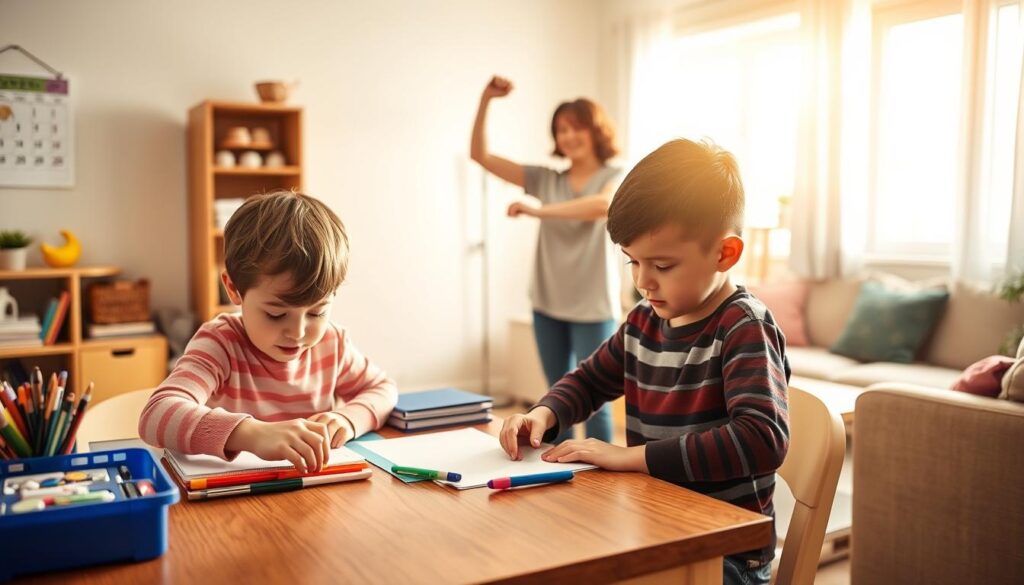Ever wonder why some children excel in school while still enjoying their free time? The secret lies in finding the right mix of learning and fun. A well-structured routine helps kids thrive academically and socially.
Today’s fast-paced world brings challenges like excessive screen time and heavy school workloads. These factors can disrupt a child’s natural growth. Studies show that structured playtime boosts focus by 30% while lowering stress levels.
Programs like Brookeville Child Care prove that a balanced approach works. Their methods blend education with creative activities. Research by Dr. Allyson Weldon highlights how early habits shape lifelong success.
Key Takeaways
- Structured play improves focus and reduces stress.
- Children with balanced routines perform better in school.
- Parents play a key role in setting healthy habits.
- Physical activity enhances learning retention.
- Age-specific schedules help maintain consistency.
Why Balancing Study and Play Is Essential for Kids
A mix of structured education and creative play fuels a child’s growth. Research from Brookeville Child Care shows that activities like puzzles and role-playing build problem-solving and communication skills. These experiences shape lifelong abilities.
Psychologists note a 25% improvement in emotional regulation when children enjoy daily unstructured play. This freedom helps them manage stress and build resilience. Controlled environments, like board games, teach conflict resolution and teamwork.
Structured activities accelerate cognitive development. Building blocks, for example, enhance hand-eye coordination by 40%. Cooking projects integrate math concepts, reinforcing learning outside the classroom.
Physical health benefits are equally vital. Active play reduces childhood obesity risks by 33%, according to CDC data. Movement also boosts focus, making study sessions more effective.
Long-term impacts are profound. Children with balanced routines show 19% higher college completion rates. As Brookeville educators state, “Play is the foundation for executive functioning skills.”
Creating a Structured Daily Routine
Routines provide the framework for academic success and joyful childhoods. A clear schedule reduces stress while teaching valuable time-management skills. Tailor plans to fit developmental stages for maximum impact.

For Younger Children (Ages 3–8)
Short, engaging sessions work best. Use timers to divide study time into 25-minute chunks with 10-minute play breaks. Progress charts with stickers motivate completion of tasks like reading or puzzles.
Color-code their weekly schedule. Blue for reading, green for math games. Dr. Weldon recommends Sunday night family planning to set the tone for the day ahead.
For Older Kids (Ages 9+)
Teach prioritization with the Eisenhower Matrix. Label assignments as urgent/non-urgent. Try a “Power Hour”: 45 minutes of focused work followed by a 15-minute tech-free break.
Gamify routines. Earn 30 minutes of video games after finishing school projects. Apps like MyStudyLife help track deadlines, while sports analogies frame homework as “practice drills.”
Set tech boundaries. No screens during study time, except for educational tools. Adjust for surprises—like pop quizzes—with flexible emergency protocols.
The Power of Play: Types and Benefits
Playtime isn’t just fun—it’s a critical part of child development. Through creative activities, children build skills that last a lifetime. Research shows playful learning boosts creativity, problem-solving, and even academic performance.
Active Play: Fuel for Body and Mind
Outdoor adventures like tag or biking improve coordination. Indoor options, such as dance parties, keep energy high on rainy days. Both types teach teamwork and resilience.
LEGO builds spatial awareness, while cooking projects turn measurements into math lessons. Rhythm games sharpen pattern recognition—key for early math success.
Structured Play: Learning Disguised as Fun
Board games like chess teach strategic thinking. Puzzles progress from 50 pieces to 3D challenges, adapting to age and ability. Science kits make concepts like supersaturation tangible.
Debate clubs formalize critical thinking through role-play. Monopoly with real-world twists introduces money management. Every task reinforces content in memorable ways.
Effective Study Techniques for Kids
Short bursts of focused work outperform marathon study sessions. Research shows that structured intervals enhance retention while preventing burnout. Tailoring methods to a child’s age and learning style makes a measurable difference.

Tailoring to Learning Styles
Younger children thrive with 15-minute study blocks and 5-minute breaks. Use tactile tools like marble jars to track progress. Older kids benefit from 25-minute sessions followed by short, active pauses.
Visual learners absorb charts or color-coded tasks. Auditory learners retain more with read-alouds. Kinesthetic learners excel when combining movement with memorization.
The Pomodoro Technique
This method divides study time into 25-minute segments with 5-minute break intervals. Families report 68% faster homework completion using this approach.
Try tech-free timers or apps like Focus Keeper. Reward completed intervals with outdoor play or creative projects. Gradually extend sessions to 50 minutes for teens.
Active pauses—like juggling or balance boards—boost energy. Group challenges turn routines into games, fostering consistency.
Teaching Time Management Skills
Mastering time management early sets children up for lifelong success. Simple tools like weekly planners divide days into study, play, and rest blocks. This visual approach makes abstract concepts tangible for young minds.
Start with picture charts for preschoolers, then transition to digital calendars. Color-coding helps distinguish between tasks—blue for reading, green for outdoor activities. The Brookeville method incorporates museum visits as educational play, blending learning with leisure.
Try backward planning: set bedtime first, then allocate hours upward. This ensures adequate rest while fitting in priorities. For older children, introduce the Eisenhower Matrix simplified as “Do Now, Decide Later, Delegate, or Delete.”
Energy mapping boosts efficiency. Schedule math for mornings when focus peaks, saving creative projects for afternoons. Tech-free hours create distraction-free zones for deep work, while timers teach pacing.
Turn chores into skill-building. Folding laundry becomes sorting practice. Cooking dinner teaches measurement and time estimation. These real-world tasks reinforce classroom concepts.
Prepare for disruptions with “Plan B” templates. A sick day might swap worksheets for educational documentaries. Gradually increase independence—teens should manage their own schedule with parental guidance.
Sports analogies make concepts stick. Compare homework to practice drills and tests to game day. This mindset shift helps children see school work as preparation rather than pressure.
Conclusion
Small changes create big impacts in a child’s daily rhythm. Programs like Diamond Study Skills prove that structured flexibility outperforms rigid schedules. Families report higher engagement when adjusting methods as children grow.
Parents set the tone. Modeling time management teaches kids to prioritize study and playtime. Community resources—libraries, museums—add variety to learning.
Brookeville’s 92% satisfaction rate highlights the power of balance. Start with one weekly tweak, like tech-free hours or active breaks. Progress, not perfection, fuels growth.
Einstein once said, “Play is the highest form of research.” Blend education with creativity, and watch your child thrive.
FAQ
Why is balancing schoolwork and playtime important for children?
A healthy mix of learning and fun supports cognitive growth, emotional well-being, and physical development. Kids who engage in both activities tend to perform better academically while staying socially active.
How can parents create a daily schedule for younger children (ages 3-8)?
Keep sessions short—20-30 minutes for focused tasks like reading or puzzles—followed by breaks for movement or creative play. Use visual timers or charts to make transitions smoother.
What are effective study methods for older kids (ages 9+)?
Techniques like the Pomodoro method (25-minute focused sessions with 5-minute breaks) work well. Encourage goal-setting and prioritize subjects based on difficulty levels.
What types of play benefit a child’s development?
Active play (running, cycling) boosts physical health, while structured games (chess, LEGO) enhance problem-solving skills. Both types foster creativity and teamwork.
How can parents teach time management to kids?
Introduce tools like planners or apps to track tasks. Break larger assignments into smaller steps and reward completed goals to build accountability.
Should screen time count as play?
Limited, educational screen time (e.g., coding games or documentaries) can supplement learning, but hands-on activities and outdoor play should dominate their free time.



